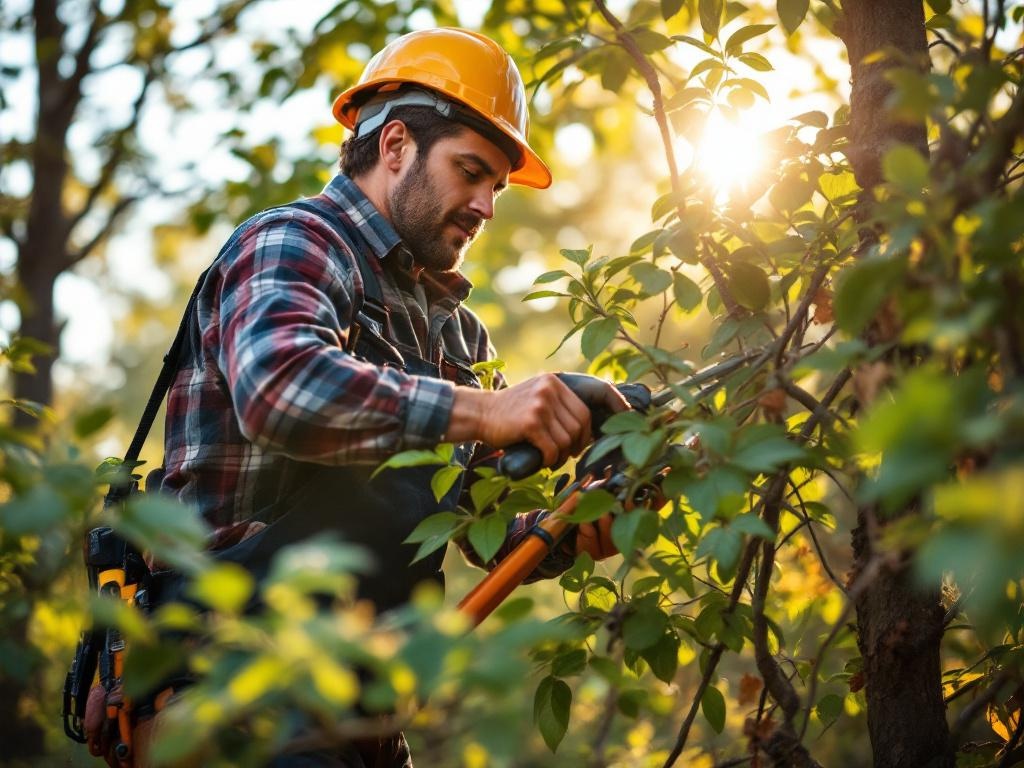Last summer, many Colorado homeowners, like yourself, may have witnessed the impact of harsh weather on their trees, leading to unexpected damage or concerns about overall tree health. Indeed, if you want to proactively avoid similar fates and ensure the long-term vitality of your arboreal investments, it’s absolutely crucial to diligently prepare your trees through proper tree pruning in Colorado best practices.
From understanding optimal timing to employing the right tools and techniques, there are several vital steps you can take to comprehensively protect your landscape. Ultimately, effective tree pruning in Colorado best practices promote not only safety but also vigorous growth and aesthetic beauty.
Let’s thoroughly explore how you can meticulously safeguard your trees against various challenges, ensuring their health and resilience for years to come.
Understanding the Profound Importance of Tree Pruning in Colorado
When you contemplate comprehensive tree care, it’s remarkably easy to overlook the critical role of pruning, but understanding its profound importance is absolutely essential for maintaining genuinely healthy, safe, and aesthetically pleasing trees. Indeed, pruning is far more than just cosmetic trimming; it’s a vital horticultural practice. First and foremost, proper tree pruning in Colorado best practices encourage strong, balanced growth by directing the tree’s energy to the most vital branches and developing a robust structural framework.
Second, it systematically removes dead, dying, or diseased branches, which can otherwise become entry points for pests and diseases, or pose significant safety hazards, especially during strong winds. Third, strategic cuts can improve air circulation within the canopy and increase sunlight exposure to inner branches, fostering healthier foliage and potentially improving fruit or flower production. Furthermore, by carefully cutting back overgrown or hazardous areas, you help your tree focus its energy on healthier parts, leading to a more resilient structure.
Additionally, proper tree pruning in Colorado best practices can prevent dangerous situations, like falling limbs during storms, which can protect your property, loved ones, and nearby structures. Finally, it significantly enhances the tree’s overall aesthetic appeal, making your landscape more inviting and manicured.
Ultimately, regular pruning not only profoundly improves your trees’ health but also consistently contributes to a vibrant and safer outdoor environment, ensuring they thrive for many years to come.
Best Times for Pruning Trees in Colorado
Timing is a critical factor in executing tree pruning best practices effectively, particularly in Colorado’s varied climate. Therefore, knowing when to prune can significantly impact your tree’s health and recovery. You’ll generally find the best times for pruning trees in Colorado fall into two primary windows: early spring and late fall.
Pruning in early spring, just before new growth unequivocally begins and before the tree expends significant energy on leaf development, is often ideal. This allows for the removal of any dead, damaged, or undesirable branches, allowing your trees to redirect their resources and thrive as they vigorously enter the active growing season. Alternatively, late fall, after leaves have completely dropped for deciduous trees and the tree has entered dormancy, is another excellent time.
This dormancy period minimizes stress on the tree, reduces sap bleeding, and allows for much better visibility of its underlying branch structure, making it easier to identify problem areas. Conversely, you should generally avoid extensive pruning in mid-summer, as this can potentially weaken your trees during their most active growth phase and make them more susceptible to pest infestations or disease.
Additionally, be cautious with heavy pruning during deep winter when temperatures drop considerably, as this can leave freshly cut wounds vulnerable to cold damage or frost cracks. Ultimately, timing your pruning correctly is an absolutely essential tree pruning in Colorado best practice for maintaining the long-term health, safety, and vitality of your trees.
Essential Pruning Tools and Effective Techniques
With the optimal timing for pruning firmly established, it’s equally important to have the right tools and master the appropriate techniques to guarantee a successful job. Indeed, using improper tools or techniques can cause more harm than good, negating the benefits of tree pruning in Colorado best practices.
Start by acquiring a pair of sharp, clean hand pruners for cutting small branches, typically up to 3/4 inch in diameter. For larger limbs, generally up to 1.5-2 inches, use sturdy loppers. For branches exceeding this, a sharp pruning saw is indispensable.
Crucially, ensure all your tools are meticulously cleaned and sharpened before and during use to ensure clean cuts and prevent the spread of diseases from one tree to another. Before you start, always prioritize safety: wear robust protective gear like heavy-duty gloves, safety goggles, and, if working overhead, a hard hat. Ensure you have stable footing on a ladder or use a pole pruner for higher branches.
Mastering the actual pruning technique is just as essential. For most cuts, always aim to cut at a slight angle, just outside the branch collar (the swollen area where the branch joins the trunk or a larger limb), and just above a healthy bud or lateral branch.
This precise cut promotes healthy growth and allows the tree to heal quickly. Avoid tearing the bark by making clean, precise cuts. For larger limbs, utilize the three-cut method to prevent bark stripping: first, an undercut about a foot from the trunk, second, a top cut slightly further out to remove the bulk of the limb, and finally, a third cut to remove the remaining stub outside the branch collar. Regularly clean your tools with rubbing alcohol or a bleach solution between trees to prevent disease spread.
With the right tools and refined techniques, you’ll ensure your trees not only survive but truly thrive as a result of diligent tree pruning in Colorado practices.
Identifying What to Prune: A Systematic Approach
To guarantee your trees remain consistently healthy, structurally sound, and aesthetically pleasing, it’s absolutely essential to accurately identify which branches specifically need pruning. This systematic approach is a core component of tree pruning best practices. Start by visually scanning the tree for obvious issues, then delve into more subtle concerns.
Here’s a quick guide to help you decide what to prune:
| Branch Condition | Description | Action to Take | Priority Level |
|---|---|---|---|
| Dead or Diseased | Branches that are brittle, discolored, or show signs of decay/fungus. | Remove immediately at the point of origin or where healthy wood begins. | High |
| Damaged | Branches broken by wind, ice, or other impacts. | Prune back to a healthy lateral branch or the branch collar. | High |
| Crossing or Rubbing | Branches that grow inward or rub against each other, creating open wounds. | Remove one of the offending branches, typically the weaker or poorly placed one. | Medium |
| Weak or V-Shaped Crotches | Branches forming narrow, tight angles with the main trunk, prone to splitting. | Remove the weaker branch or reduce its size to promote a stronger union. | Medium |
| Suckers and Water Sprouts | Fast-growing, vertical shoots arising from the base of the tree (suckers) or along branches (water sprouts). | Remove completely as they compete for nutrients and don’t contribute to structure. | Medium |
| Overgrown or Obstructing | Branches that block pathways, obscure views, or interfere with structures/utilities. | Shape for balance and clearance, making thinning cuts rather than topping. | Low (Aesthetic/Clearance) |
By systematically evaluating these conditions, you ensure your pruning efforts are targeted, beneficial, and contribute to the long-term health and safety of your trees, making them essential tree pruning best practices.
Pruning Different Tree Species: Tailoring Your Approach
While the fundamental tree pruning in Colorado best practices (like removing dead wood) apply broadly, understanding that each tree species has its unique growth habits, flowering cycles, and specific needs is absolutely crucial for truly effective and beneficial pruning. Indeed, a one-size-fits-all approach can harm certain trees.
- Deciduous Trees (e.g., Maples, Oaks, Elms): These trees lose their leaves in fall. They are generally best pruned in late winter or early spring (dormant pruning), before new growth emerges. This allows for clear visibility of the branch structure and minimizes the risk of pest infestation or disease entry points, promoting vigorous growth once spring arrives.
- Evergreens (e.g., Pines, Spruces, Firs): These trees retain their needles year-round. They are typically best pruned in late spring after new growth (candles) appears and hardens, or in early summer. Avoid heavy pruning in late fall or winter, as new growth might not harden off before cold weather, making it susceptible to frost damage.
- Flowering Trees (e.g., Crabapples, Cherries, Dogwoods): The timing for these depends on when they bloom. If they bloom in spring on old wood (e.g., Dogwoods, Forsythia), prune immediately after flowering to avoid cutting off next year’s blossoms. Conversely, if they bloom in summer on new wood (e.g., Crape Myrtles, Roses), prune in late winter or early spring before new growth emerges. You’ll want to avoid cutting into old wood on these types of trees if you value their blooms.
- Fruit Trees: These often require specialized pruning techniques (e.g., structural pruning for scaffold limbs, renewal pruning) to maximize fruit production and maintain tree health. This often involves detailed knowledge of fruit spurs.
Familiarizing yourself with these specific needs for each tree species guarantees your trees remain healthy, structurally sound, and continue to thrive in Colorado’s diverse climate, making your pruning truly effective.
Common Pruning Mistakes to Absolutely Avoid
Avoiding common pruning mistakes is absolutely essential for maintaining the long-term health, structural integrity, and aesthetic appearance of your trees. Indeed, a single incorrect cut can cause irreversible damage, negating all the benefits of diligent tree pruning in Colorado best practices. Here are some critical pitfalls to diligently watch out for:
| Mistake | Description | Solution |
|---|---|---|
| Over-pruning | Removing too much foliage (more than 25% of the canopy) in a single season. | Prune selectively and gradually over several seasons, focusing on targeted cuts. |
| Improper Timing | Pruning at the wrong season for the tree species, especially during active growth for heavy cuts or too late in fall. | Research the best dormant or post-bloom times for your specific tree species. |
| Using Dull or Dirty Tools | Dull blades tear the bark, creating jagged wounds that are slow to heal and prone to disease. Dirty tools can spread pathogens. | Regularly sharpen your pruning tools and disinfect them with rubbing alcohol or a bleach solution between trees. |
| Topping (Heading Cuts) | Cutting main branches back to stubs, often leaving large wounds and encouraging weak, rapid, upright growth (water sprouts). | Avoid topping at all costs. Instead, make thinning cuts back to a lateral branch or the branch collar. |
| Leaving Stubs or Flush Cuts | Leaving a stub makes it difficult for the tree to heal. Cutting flush with the trunk removes the branch collar, which contains healing tissue. | Always make cuts just outside the branch collar, allowing the tree to compartmentalize the wound effectively. |
| Neglecting Safety | Pruning without protective gear, using unstable ladders, or working too close to power lines. | Always wear appropriate PPE (gloves, safety glasses, hard hat). Use stable, appropriate ladders. For high branches or branches near power lines, always call a professional arborist. |
By being aware of these common errors and consciously avoiding them, you can ensure your pruning efforts are beneficial, safe, and truly contribute to the vitality of your trees, making them a testament to effective tree pruning best practices.
In conclusion, tree pruning is unequivocally far more than just a routine chore; it is an essential art and science for keeping your Colorado trees healthy, safe, and aesthetically magnificent.
By meticulously understanding when precisely to prune (early spring or late fall), consistently utilizing the right sharp tools, and, crucially, avoiding common, detrimental mistakes like over-pruning or topping, you can profoundly ensure your trees not only survive but truly thrive. Indeed, remember to diligently identify which branches to trim based on their condition (dead, diseased, crossing) and always tailor your approach to the specific needs of each tree species.
Ultimately, with these tree pruning in Colorado best practices firmly in mind, you’ll not only enhance the visual beauty and structural integrity of your landscape but also promote the long-term vitality and resilience of your trees, fostering a safer and more vibrant outdoor environment for years to come.
For professional service and Expert tree care services contact Above and Beyond to learn more.
Key Takeaways: Mastering Tree Pruning Best Practices
- Optimal Timing: Prune in early spring or late fall to significantly minimize stress on the tree and encourage healthy growth during active seasons, a key
tree pruning best practice. - Appropriate Tools: Utilize sharp, clean, and appropriate tools like hand pruners for small branches, loppers for medium limbs, and pruning saws for larger ones, ensuring precise cuts that promote
tree health. - Targeted Removal: Focus on meticulously removing dead, diseased, or crossing branches immediately to prevent pest attraction, disease spread, and structural damage.
- Safety First: Prioritize safety by consistently wearing robust protective gear (gloves, goggles, hard hat) and ensuring stable footing when pruning, especially at height.
- Avoid Over-pruning: Never remove more than 25% of a tree’s canopy in a single season, and avoid cutting into old wood on specific flowering trees to preserve their blooms and overall vitality.
- Species-Specific Care: Understand that different tree species have unique pruning needs and growth habits, requiring tailored
tree pruning best practices.




